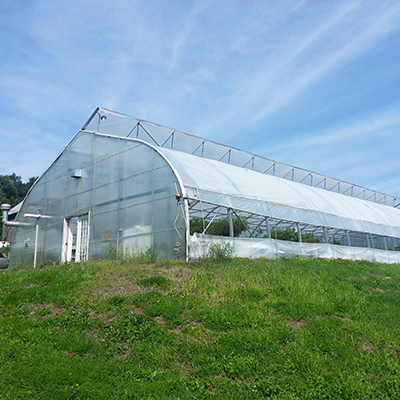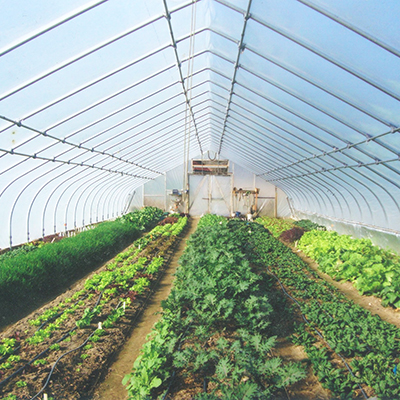In the hoophouse plants grow bigger and faster. We want to avoid anything that slows growth down. All that growing burns up the organic matter and nutrients in the soil at a fast rate, particularly in hot, humid climates. We need to replenish the soil more generously and more often than we do outdoors. Good soil health means having enough plant nutrients, not surplus. If you have too much soluble nitrogen (N), it can leach into the groundwater or burn up the organic matter. Using manure or compost for a nitrogen source can cause the build-up of excess phosphorus (P).
There are four main principles of soil health management:
Keep healthy plants growing year-round. This will keep carbon moving from the air into the soil, protect the soil surface, build up organic matter, improve the soil structure and feed the soil micro-organisms.
Maximize the volume of living roots throughout the soil profile (use both deep- rooted and shallow-rooted crops).
Keep soil disturbances to the essential minimum: physical (tillage and traffic), biological (admitting invasive alien species) and chemical (adding amendments and fertilizers). Tillage accelerates nutrient burn-up and hence the loss of organic matter. The N needed for good crop yields may be more than optimum for the organic matter, soil health, and the environment.
Increase the soil biodiversity via crop rotations, interplanting, multispecies cover crops and the addition of amendments to act as microbial inoculants, enhance the habitat for soil life, address any nutrient or pH imbalances, and replenish the organic matter and nutrients used up by the growing crops.
Soil tests
Get an annual soil test in the fall, from the same agency each time—different labs sometimes use varying test methods. Also, soil collected in spring is usually higher in P than soil collected in the fall. Consult an agronomy book, your ex- tension service, or a live agronomist for help in interpreting your test results. Most soil tests don’t include a measure of organic matter as this can vary a lot from week to week. My state extension service provides standard tests for soil pH, phosphorus (P), potassium (K), calcium (Ca), magnesium (Mg), zinc (Zn), manganese (Mn), copper (Cu), iron (Fe), boron (B), and estimated cation exchange capacity (CEC), plus a fertilizer and lime recommendation.
This is free to commercial farmers in Virginia. For a small fee there are special tests for soluble salts (see Chapter 28, Salt Build-Up) and organic matter. Some companies offer compost and potting soil tests which may be more appropriate for hoophouse soils, as well as nutrient analyses of compost, composted manure and other organic fertilizers. Specialized labs conduct soil food web analyses, measuring the bacteria-to-fungi ratio, mycorrhizal fungi, indicator soil microbial enzymes, nematode populations, and biodiversity.
You can assess soil health yourself—consider the soil tilth (particle size), color, water infiltration rate, resilience to stress, earthworm count, crop yield and quality, organic matter, pH, nutrient levels and trends on your soil tests. You can run your own soil tests. Soil health test kits are sold by Gempler’s and others. See the NRCS Soil Quality Test Kit page to learn how to do this, their Soil Health for Educators page to learn how to make your own soil health test kit, and their Soil Quality Test Bucket Checklist. Soil health assessments include measures of total soil organic matter (or organic carbon), active organic carbon, total and active organic nitrogen, total and active microbial biomass, and soil respiration.
Amendments and imbalance
Hoophouse soils are not exposed to regular leaching from rainfall, and high levels of soluble salts, including nitrate, potassium, and sulfate from fertilizers or organic materials like compost can build up and stunt plant growth. See Chapter 28, Salt Build-Up. Some of the salt problems in high tunnels are caused by having very high organic matter levels, due to heavy amendment with composts or manures. In high OM soils, when warm or when irrigated after a dry spell, large flushes of nitrate can occur. This makes it difficult to manage nitrogen in hoophouses. Pre-sidedress soil nitrate testing (PSNT) and/or foliar testing during the growing season are good nutrient management tools.
To compensate for much higher yields and higher nutrient demand, soil macronutrients (N- P-K) are deliberately maintained at higher levels in hoophouse production than in field production. Organic amendments include soil inoculants, organic mulches, biochar and other soil conditioners, lime and other natural minerals, manure and other organic fertilizers, such as alfalfa meal, soybean meal, fish meal, kelp, composted chicken litter and compost.
Most growers are lavish with compost in the hoophouse, even if nowhere else. Good quality finished compost is a way to add organic matter and nutrients. Compost can add a range of beneficial bacteria and fungi, which can inoculate plants against diseases by inducing systemic acquired resistance. The plants produce antibodies and other protective compounds before any infection can occur. Compost improves the soil structure, organic matter and humus. The effects last longer than cover crops and crop residues, especially in humid conditions where the break- down of plant material is very rapid.
How much compost is too much? Some of us were raised to think of compost as the gold standard soil improver, and find it hard to believe there can be too much of a good thing. Others may consider compost like salad dressing—something to add that je ne sais quoi to a good meal. We use four wheelbarrowfuls per 4’ × 96’ (1.2 × 29 m) bed. Our rate of about 46 gals/100 ft2 (680 L/36 m2 bed) is at the generous end of the spectrum. Other professional growers use anywhere from 12–40 gals/100 ft2 (5–17 L/m2). We prefer to use home- grown inputs rather than off-farm inputs. See Chapter 23, Cold Weather Care, for calculations.
Compared with poultry litter compost (lower C:N ratio), on-farm mixed compost (high C:N) leads to higher total soil organic C and better water infiltration. Poultry litter compost can enhance organic matter and N mineralization potential over conventional systems, but can lead to excess P. In terms of organic matter, composted manure is better than uncomposted solid manure, and both add more than slurry manure (which provides very low C:N; and half of the N is ammonium). Manure and compost can add too much P relative to N and K. It is worthwhile to understand the effect of phosphorus.
P in the soil and in plants
Phosphorus is needed for cell division, hence to promote root formation and growth, seedling vigor, flowering, crop maturity and seed pro- duction, and to improve winter hardiness in fall plantings. Phosphorus is important in fat, car- bon, hydrogen and oxygen metabolism, in respiration, and in photosynthesis. It is stored in seeds and fruit.
Phosphorus binds easily with many other minerals in the soil, forming compounds that are not very soluble in water, therefore most of the phosphate in soils exists in solid form and does not move freely with soil water. Although phosphorus is very mobile within plants, it is relatively immobile in soil and does not leach readily in normal rainfall or irrigation.
Phosphorus is most available to plants between soil pH of 6 and 7.5, especially between pH 6.5 and 6.8. In neutral and alkaline soils phosphorus is mostly present as insoluble calcium phosphates. In acid soils below pH 5.5, most of the phosphorus is bound as iron phosphate or aluminum phosphate, compounds that further change gradually into very insoluble compounds not available to plants. If a soil test shows a pH that is far from neutral, with a slightly low phosphorus level, correct the pH and repeat the soil test before amending the phosphorus level.
In the soil water, phosphorus is only present in very small amounts, but when removed by plants, supplies are quickly replenished from the “active P pool” (phosphorus in solid compounds which is relatively easily released to the soil solution). The “fixed P pool” contains inorganic phosphate compounds that are very insoluble, and organic compounds that are resistant to mineralization by micro-organisms in the soil. Although some slow conversion between the fixed P pool and the active P pool does occur in the soil, phosphate may remain for years without being available to plants and may have very little impact on soil fertility.
Since the movement of phosphates in soils is very limited, roots have to grow to the phosphorus—it will not move towards the plants. Manure contains soluble phosphate, organic phosphate, and inorganic phosphate compounds that are quite available. Water-soluble forms generally become insoluble very soon after application to the soil.
Phosphorus deficiency
In cold soils less phosphorus is available from organic materials, because biological activity is required to release it and that is low when it’s cold. Also, roots cannot absorb phosphorus well from cool soils. Early spring brassicas can show red or purplish colors (anthocyanin pigment) in the leaves, especially undersides, and the lower stems. Cell necrosis may follow. Root growth will be poor, plants may exhibit stunting and delayed maturity. Tomato plants may have yellow leaves, with purpling on the underside of leaves. They may exhibit reduced flowering and delayed maturity. To avoid phosphorus deficiency problems, wait until the soil is 60°F (15.5°C) before planting.
Mycorrhizae are symbioses of species of fungi living in a biologically active soil, with plant roots. The mycorrhizal fungi infiltrate plant roots in a mutualistic arrangement, using some carbohydrates produced by the plant, and pro- viding supplementary phosphorus to the plant. The fungal hyphae (threads of the underground mycelium) extend over a wide area of soil, absorbing minerals, including phosphorus, which they transfer to the plant. The success of plants in low phosphorus soils may be due to mycorrhizae.
Excess phosphorus
The main symptom of excessive phosphorus in soil is stunted plant growth. High phosphorus interferes with nitrogen absorption. Also there may be symptoms of deficiencies of zinc, iron, cobalt or calcium, because the phosphorus has locked up these nutrients. Zinc deficiency shows as bleaching of plant tissue, iron deficiency as yellowing between leaf veins. Cobalt is involved in the process by which the plant stem grows, shoot tips elongate, and leaves expand. Calcium deficiency produces blossom end rot of tomatoes.
Phosphorus inhibits the growth of mycorrhizae which help the plant absorb water and nutrients. A high presence of non-mycorrhizal weeds such as velvetleaf, lamb’s quarters, pigweed and galinsoga can be signs of excess phosphorus, explained Klaas Martens at MOFGA’s 2009 Spring Growth Conference.
Aside from plant growth problems, the issues with having very high phosphorus levels in your soil include that if it reaches waterways it can accelerate eutrophication—the nutrient enrichment of surface water leading to problem algal growth. When an algal bloom dies, it decomposes, using up the oxygen in the water, so fish and other organisms die too.
Phosphorus is a paradoxical element in that it is an essential nutrient, is not toxic itself and has low solubility, but can have damaging effects on water quality at quite low concentrations. Because phosphorus is usually locked up, leaching of soluble phosphorus from soils is not normally a problem, but if soil particles are carried to a river or lake, phosphorus is contained in this sediment.
Poor manure handling practices do lead to high phosphorus problems in waterways. Many of the best management practices (BMPs) advocated focus only on short-term solutions (such as grass filter strips, not applying manure on frozen soil, or soil erosion control) rather than correcting the cause of the problem, which is a nutrient imbalance. The phosphorus inputs on a farm should roughly balance the outputs.
Mitigating high phosphorus levels
The quickest way to reduce excess soil phosphorus (which can take years!) is to stop any manure or compost application while continuing to grow crops that can be exported from the farm. Livestock farmers can have big problems with finding safe uses of their high-P manures. See the University of Idaho Extension publication, Mitigating High-Phosphorus Soils. One solution is to compost manure and sell it off the farm to vegetable growers.
Conversely, one solution for vegetable growers may be to grow cover crops as forage crops, and graze or bale grass crops to sell off the farm as livestock feed. For example, triticale is very good at removing phosphorus from the soil and producing winter forage. The phosphorus removed ranges from 7–36 pounds/ acre (7.8–40 kg/ha). The more phosphorus your soil has, then the higher the phosphorus level in triticale grown in that soil. Double cropping can remove phosphorus at twice the rate.
Vegetable growers do not have the problem of phosphorus accumulation to such a big degree, nor do vegetable crops remove phosphorus at the rate forages do. See the New England Vegetable Management Guide Removal of Nutrients from the Soil for a table of Approximate Nutrient Removal by Selected Vegetable Crops. The best vegetable removers of phosphorus are celery (80 lbs P2O5/acre, 90 kg/ha), tomatoes (72 lbs, 81 kg), potatoes (65 lbs, 73 kg), sweet potatoes (60 lbs, 67 kg), peppers (52 lbs, 58 kg, fruits only), cu- cumbers (33–72 lbs, 37–81 kg), eggplant (56 lbs, 63 kg). Onions remove about 25 lbs (28 kg/ha)— one-quarter of the phosphorus removed by alfalfa hay (104 lbs, 117 kg). In all cases, to achieve results this high, grow high yields and remove the plants too, although you can’t sell those! Beans and peas are in the 7–10 lbs (8–11 kg) range if just pods, 20 lbs (22 kg) with vines. Actual phosphorus is 43.7% of the P2O5 measured.
Because hoophouses are such valuable real estate, growers may be reluctant to switch to less profitable crops in them. An alternative management strategy is to move the hoophouse and use the “fresh air” years to reduce the phosphorus in the soil.
Strategies to reduce the amount of phosphorus added each year include adjusting your compost use rates according to soil test P results. On low-P soil, use at rates to meet the soil needs for N or K, which will increase phosphorus levels. If the soil phosphorus is high or optimum, use compost sufficient to just replenish P, and legume cover crops (or legume food crops) to supplement N.
For very high or excess soil phosphorus, only use compost sparingly as a micro- organism inoculant, rather than a fertilizer, and if test reports show more than 40 lbs P per acre (45 kg/ha), consider using only soil amendments containing little or no phosphorus. If phosphorus levels are excessive, avoid using manure com- posts (high in phosphorus), and other fertilizers and amendments containing phosphorus. Add more carbon (“brown”) ingredients to compost you make on-farm.
Cover crops
The hoophouse is not an easy place to grow cover crops. If you have designed yours so that you can open up the ends and drive your riding tractor and implements through, you could grow cover crops. If you use a walk-behind tractor in there, you could grow the shorter, less rambunctious cover crops. If you use only hand tools, this will restrict any cover crops you consider. Buckwheat, mustard, soy, cowpeas may still be options. The grass crops are hard to deal with using only hand tools. One reason to use only hand tools is in order to reduce soil disturbance: tillage burns up the organic matter.
Secondly, you may not want to give up the space for cover crops when you could be growing food crops in the wonderful protected environment. You may choose to bring in your nutrients from elsewhere, either off-the-farm or home-produced.
In tropical areas, in order to replenish the soil, some organic farmers grow food crops for eight months and cover crops for four, even though they do not have winter conditions that prevent growing food crops year-round. Hoophouse growers who do not need high summer crops could use that time to grow cover crops. Sweet potatoes or cowpeas are used as summer “smother crops,” (and you can harvest the sweet potatoes). Cowpeas (such as Iron and Clay) with a relatively upright growth habit compete better against weeds than prostate types.
Many studies have confirmed the soil bene- fits of cover crops. The root channels improve the soil structure—fine roots make up 70% of the root biomass of crimson clover, vetches, and field peas, and when the cover crops are mowed, these roots support microbial growth, form active organic matter, and rapidly release N to the plants. So, if you cannot easily incorporate cover crops into your hoophouse soil, consider no-till cover crops which become mulch, or grow com- post crops there. Cutting and removing the top growth to make a source of nutrients for later, or even for a field crop, still leaves the beneficial roots in your hoophouse soil.
Radishes as a cover crop can help control pest nematodes. I have not tried this, because harlequin bugs attack our brassicas and we don’t want to encourage more. Also we need to keep crop rotations in mind, and we do grow a lot of brassica food crops. Mark Schonbeck includes them in his Cover Crops for All Seasons, on the VABF website. Use daikon, oilseed or fodder radish. Sow at 10–20 lbs/ac (11–22 kg/ha) at a depth of 0.5” (1 cm) in early spring for maturation in June, or in late summer to mature in October, or to be winter-killed once temperatures reach 20°F (–7°C). Radish cover crops grow to a height of 1.5’–3’ (0.4–1 m), and produce 1.5–3 tons/ac (3,360–6,700 kg/ha) of biomass.
Radishes are semi-hardy crops that root deep into the subsoil, breaking up hardpan. They scavenge and conserve soluble soil nutrients, including nitrogen, and shade out weeds through their fast-growing canopy closure. Their strongly allelopathic root exudates inhibit weed seeds from germinating. They can also inhibit seeds of the next crop from germinating, but the effect subsides after a few weeks.
The SARE book Managing Cover Crops Profitably has good information on all kinds of brassicas as cover crops. Similar information is available from eXtension, under the Organic Agriculture Resource Area, including a webinar on winter-killed cover crops for suitable climates.
The Year-Round Hoophouse is available from Growing for Market for $32.99, or $26.39 for GFM subscribers, who always get 20% off all books. Or, get the Greenhouse/Hoophouse bundle, with our three best-selling books on the subject for the price of two, including The Year-Round Hoophouse, The Hoophouse Handbook, and The Greenhouse and Hoophouse Grower's Handbook. All three books are only $67.94, or $54.35 for subscribers.
Pam Dawling has lived at Twin Oaks Community in central Virginia for 26 years, growing vegetables for 100 people on 3.5 acres, training members in sustainable vegetable production. She is the author of two books- Sustainable Market Farming and The Year-Round Hoophouse. She blogs at www.sustainablemarketfarming.com and on Facebook.
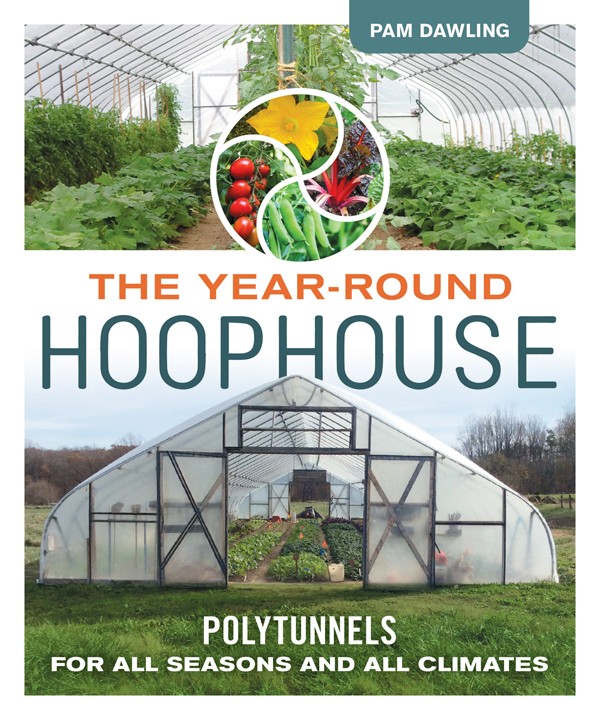
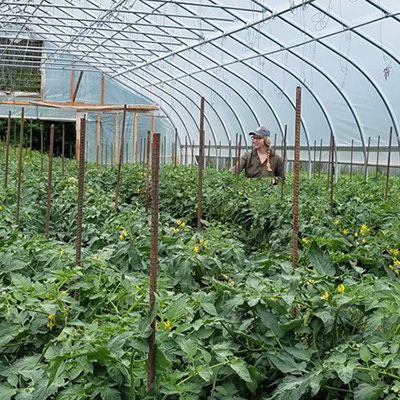
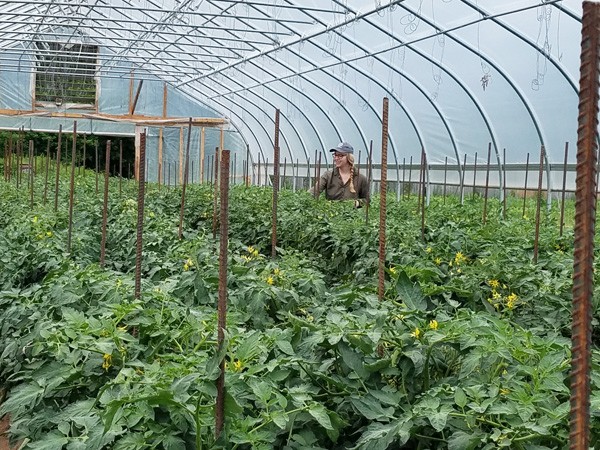 High tunnels have played a crucial role in season extension for market growers, with popularity increasing over the last decade to meet demand for locally grown produce year round (or close to it). Once built, the high tunnel becomes some of the most valuable real estate on the farm and many growers are able to produce exceptional yields in the first few years. After several seasons, yields begin to decline and many growers struggle to maintain productivity.
High tunnels have played a crucial role in season extension for market growers, with popularity increasing over the last decade to meet demand for locally grown produce year round (or close to it). Once built, the high tunnel becomes some of the most valuable real estate on the farm and many growers are able to produce exceptional yields in the first few years. After several seasons, yields begin to decline and many growers struggle to maintain productivity. 
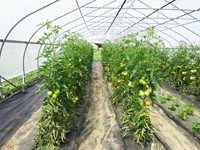
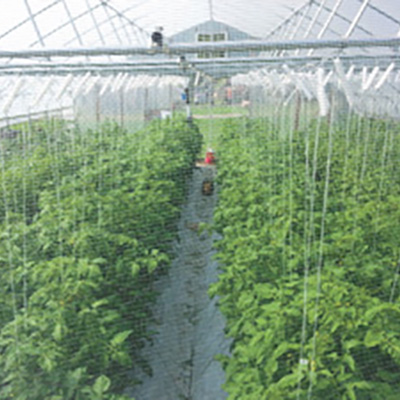

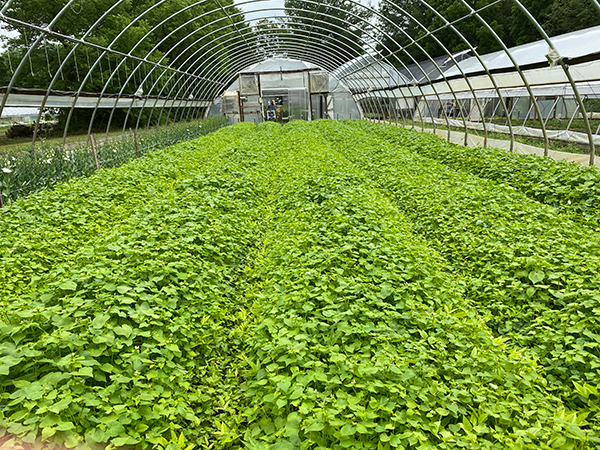 Over the last 10 years, there has been a lot of information coming out pertaining to growing veggies in soil in greenhouses. We wanted to share some of what we’ve learned over the past 13 years growing flowers under plastic and touch on some new approaches we’ve implemented since we last wrote about greenhouse growing (see our GFM articles in November 2014, November 2015, and April 2018).
Over the last 10 years, there has been a lot of information coming out pertaining to growing veggies in soil in greenhouses. We wanted to share some of what we’ve learned over the past 13 years growing flowers under plastic and touch on some new approaches we’ve implemented since we last wrote about greenhouse growing (see our GFM articles in November 2014, November 2015, and April 2018).
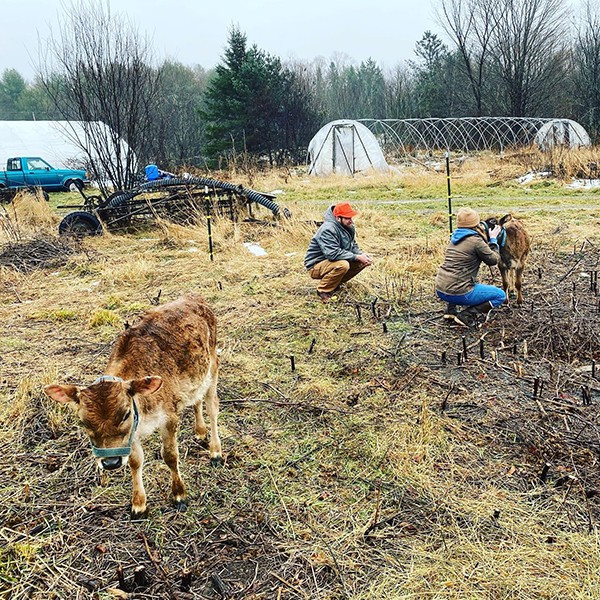 Why two of our hoophouses are named because of Emily
Why two of our hoophouses are named because of Emily
 As soon as we start driving our routes in the spring our customers ask us when we’ll have roselilies. They’re that popular and have become a signature crop for us. They’re basically a type of oriental lily, but with multiple layers of petals, and without stamens and pistils (i.e. no pollen!).
As soon as we start driving our routes in the spring our customers ask us when we’ll have roselilies. They’re that popular and have become a signature crop for us. They’re basically a type of oriental lily, but with multiple layers of petals, and without stamens and pistils (i.e. no pollen!). 
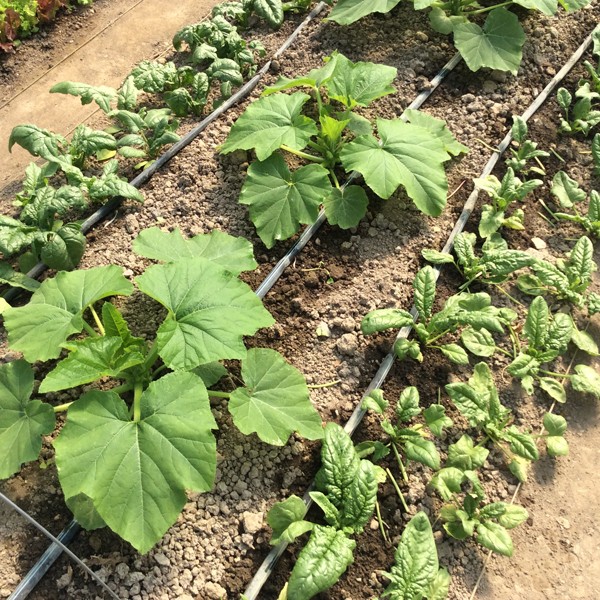 We have three main seasons in our zone 7 central Virginia hoophouse: fall-winter (October to March), spring-early summer (March to July) and high summer (August and September). We grow one bed (90’/27.5 m or so) each of yellow squash and bush cucumbers in the spring-summer season, for reliable early harvests and to help with crop rotation. If you farm in a colder climate than ours, you might be questioning allocating the precious real estate to a crop that so quickly goes from desirable to over-abundant, especially when there are more profitable things to give the space to. One reason is a difference between southern and northern climates.
We have three main seasons in our zone 7 central Virginia hoophouse: fall-winter (October to March), spring-early summer (March to July) and high summer (August and September). We grow one bed (90’/27.5 m or so) each of yellow squash and bush cucumbers in the spring-summer season, for reliable early harvests and to help with crop rotation. If you farm in a colder climate than ours, you might be questioning allocating the precious real estate to a crop that so quickly goes from desirable to over-abundant, especially when there are more profitable things to give the space to. One reason is a difference between southern and northern climates.
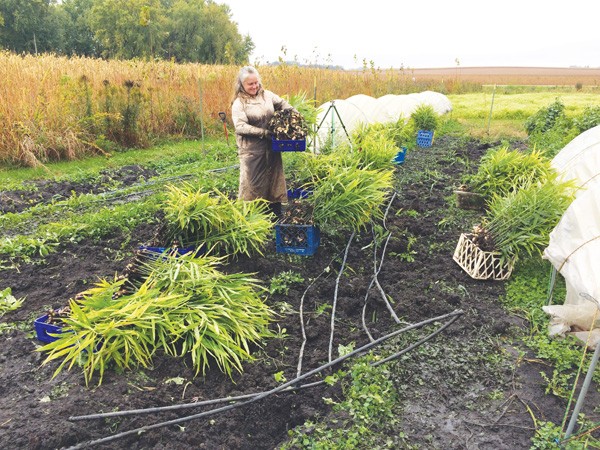 Local and organic ginger is a high-value crop that in the right market can be in high demand. Growing this tropical crop in the Midwest can be a challenge, and thus far, farmers thought they had to own a high tunnel to ensure adequate heat during the variable spring and fall seasons. High tunnel space on most farms is at a premium, so it is expensive space to devote to a long-season crop.
Local and organic ginger is a high-value crop that in the right market can be in high demand. Growing this tropical crop in the Midwest can be a challenge, and thus far, farmers thought they had to own a high tunnel to ensure adequate heat during the variable spring and fall seasons. High tunnel space on most farms is at a premium, so it is expensive space to devote to a long-season crop. 
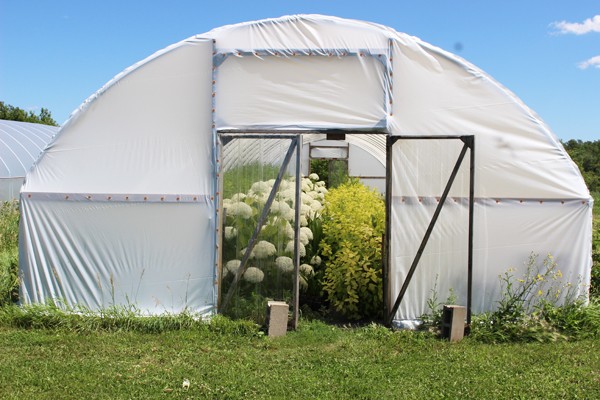 With protected space on the farm at a premium, we have to choose wisely when deciding which crops are worth putting under cover. We start out by deciding what to grow overall, and then deciding how much of that can fit inside structures, by doing a little revenue and profit analysis. Quickbooks is used to record sales, so it’s easy to list sales per item at the end of the year to see what brought in the most revenue. A version of that report extracted to a spreadsheet calculates profit per square foot by first subtracting the costs of plugs or bulbs, and then dividing by the cultivated area for each item.
With protected space on the farm at a premium, we have to choose wisely when deciding which crops are worth putting under cover. We start out by deciding what to grow overall, and then deciding how much of that can fit inside structures, by doing a little revenue and profit analysis. Quickbooks is used to record sales, so it’s easy to list sales per item at the end of the year to see what brought in the most revenue. A version of that report extracted to a spreadsheet calculates profit per square foot by first subtracting the costs of plugs or bulbs, and then dividing by the cultivated area for each item. 
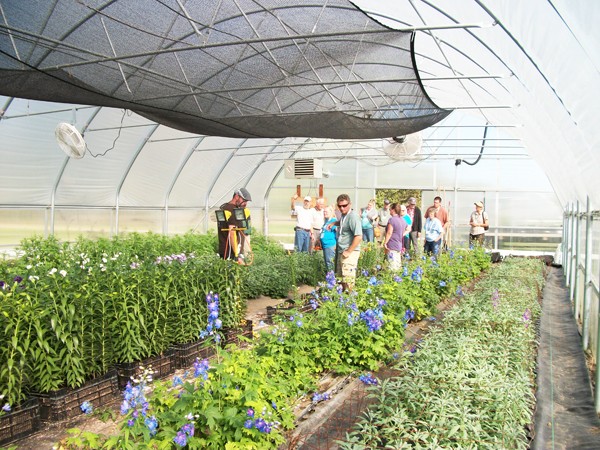 Prairie Garden Farm has been growing cut flowers for florists and studio designers since 2010. As we’re on an exposed hillside in west-central Minnesota, we’re dependent on protected culture to grow quality flowers. This article describes our approach – planning, financial, and operational details - that helps us make the most of our structures.
Prairie Garden Farm has been growing cut flowers for florists and studio designers since 2010. As we’re on an exposed hillside in west-central Minnesota, we’re dependent on protected culture to grow quality flowers. This article describes our approach – planning, financial, and operational details - that helps us make the most of our structures.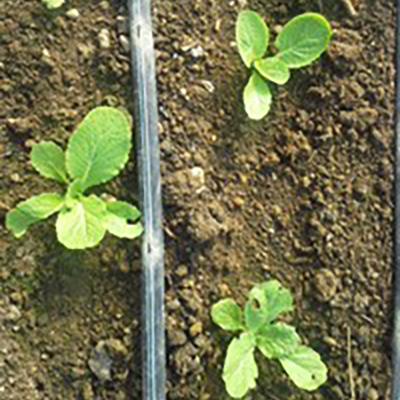
 When we talk about high salt levels in soils we do not mean simply sodium chloride, as we would if we complained of too much salt in our soup. “Salts” in the agricultural sense means all soluble ions or nutrients - nitrate, ammonium, potassium, calcium, magnesium, chloride and sulfate. Remember that these are essential nutrients – they are our friends. As with much in agriculture, soluble salt concentration is a matter of balance.
When we talk about high salt levels in soils we do not mean simply sodium chloride, as we would if we complained of too much salt in our soup. “Salts” in the agricultural sense means all soluble ions or nutrients - nitrate, ammonium, potassium, calcium, magnesium, chloride and sulfate. Remember that these are essential nutrients – they are our friends. As with much in agriculture, soluble salt concentration is a matter of balance.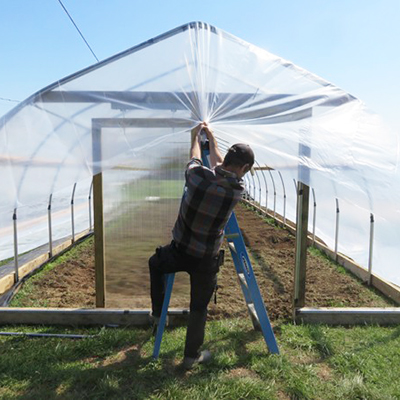
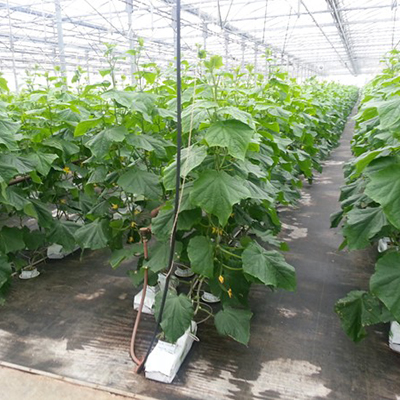
 I’ve often wondered why more market growers don’t use umbrella pruning for greenhouse and hoophouse cucumbers. It’s probably the most common way of growing cukes in greenhouses, and translates well to hoophouses and smaller structures with trellising in the 6-7’ range. I’m pretty sure the reason it’s not used more is unfamiliarity, since most smaller growers I’ve talked with don’t know about it. It’s called umbrella style because the main stem is grown up a string (the umbrella handle), topped at the wire, and two suckers are allowed to grow out to each side (the umbrella canopy).
I’ve often wondered why more market growers don’t use umbrella pruning for greenhouse and hoophouse cucumbers. It’s probably the most common way of growing cukes in greenhouses, and translates well to hoophouses and smaller structures with trellising in the 6-7’ range. I’m pretty sure the reason it’s not used more is unfamiliarity, since most smaller growers I’ve talked with don’t know about it. It’s called umbrella style because the main stem is grown up a string (the umbrella handle), topped at the wire, and two suckers are allowed to grow out to each side (the umbrella canopy).